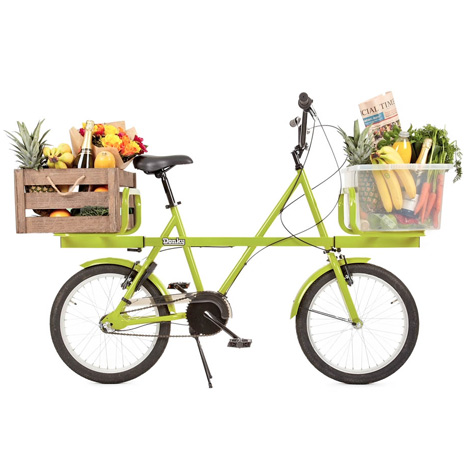The Sky's the Limit for Singapore's First Vertical Farm
by: Core77, 2012-11-08 04:00:00 UTC
 Photo: Olivia Siong, Channel NewsAsia)
Photo: Olivia Siong, Channel NewsAsia)
Ok, not quite—the aluminum frame for the Sky Greens innovative planting system tops out at about nine meters, or about three stories. But considering that the farm yields some five to ten times more than conventional methods, the metaphor stands at least as tall as the pulley-equipped towers: according to their website, "the A-Go-Gro system uses patented low carbon hydraulic green technology to power the rotation of the tower at very low energy costs, while still allowing the plants to get more than adequate sunlight."

Channel NewsAsia reports that the Singapore-based company has been supplying local supermarket chain FairPrice Finest with locally-grown produce. The veggies have been a hit, selling out despite the nominal 10–20-cent markup—as fast as the farm can grow 'em, at a rate of roughly half a tonne daily. The goal is to expand from 120 towers to 300 by 2013 at a cost of S$27m (~$22m in USD), which is projected to quadruple the output to two tonnes per day.
(more...)


 Surprising News About Bicycle-Powered Electricity Generators
Surprising News About Bicycle-Powered Electricity Generators
by: Core77, 2012-11-08 09:00:00 UTC

That hourglass-shaped device is the PowerPac, an energy storage device meant to be powered by a human on a stationary bicycle. Conceived of by South African design firm Ideso, the PowerPac won a Red Dot Design Award in the "Best of the Best" category.
"Our aim was to create an aesthetically pleasing, user-friendly and functional design that marries the fluidity of cycling with dynamic power generation," says Ideso MD, Marc Ruwiel. "It can be used by avid cyclists who can reduce CO2 emissions and generate their own electrical power, while enjoying a good workout at home."
I'm all for people-powered electricity generators, and I would've loved to have one of these during the recent blackout, but something struck me in the copy: "...An average cyclist could fully charge the battery from empty with 80 minutes of cycling and 132Wh of charge/potential energy can be stored in the battery." The "Wh" designation stands for watt-hour, and "132Wh" means you could power a 132-watt device for 1 hour. For 80 minutes of cycling to yield, say, just over two hours of light from a 60-watt bulb sounds like a low yield, doesn't it? My first thought was, can that be right?
I did a little digging, and here's what I found. It turns out hooking a bicycle up to something that directly powers a mechanical device is a fairly efficient way to generate energy. Rig a bicycle up to drive a sewing machine or a hand mixer and you get decent bang for your buck. But the second you get batteries and electricity involved, the efficiency drops way, way off. An article in Low-tech Magazine called "Bike powered electricity generators are not sustainable" explains why:
...Generating electricity is far from the most efficient way to apply pedal power, due to the internal energy losses in the battery, the battery management system, other electronic parts, and the motor/generator. These energy losses add up quickly: 10 to 35 percent in the battery, 10 to 20 percent in the motor/generator and 5 to 15 percent in the converter (which converts direct current to alternate current). The energy loss in the voltage regulator (or DC to DC converter, which prevents you from blowing up the battery) is about 25 percent. This means that the total energy loss in a pedal powered generator will be 42 to 67.5 percent....
And it even turns out that the bicycle itself has mechanical inefficiencies that suck up more energy:
(more...)


 Waterfree Urinals to Save Bard Over 500,000 Gallons
Waterfree Urinals to Save Bard Over 500,000 Gallons
by: Environmental Leader, 2012-11-08 14:50:14 UTC

Bard College has replaced its flushing urinals with Falcon Waterfree Technologies urinals, which will save more than 500,000 gallons of water a year, according to the waterfree urinals maker. These water savings, the school says, will increase Bard’s Sustainability Tracking, Assessment & Rating System (STARS) score, which measures how environmentally friendly a college or university [...]
 Donky Bike by Ben Wilson
Donky Bike by Ben Wilson
by: Dezeen, 2012-11-08 12:00:36 UTC

The steel beam running through this compact bicycle by British industrial designer Ben Wilson means it can carry heavy loads on its front and rear platforms (+ slideshow + movie). (more…)


 Low Tech Rocking Chair Knits Hats As You Sit (Video)
Low Tech Rocking Chair Knits Hats As You Sit (Video)
by: TreeHugger Design, 2012-11-06 20:13:18 UTC

This re-interpreted rocking chair allows the sitter to slowly knit a hat with no extra effort.
studio inbetween: one piece of lamp
by: Designboom - Weblog, 2012-11-05 03:16:00 UTC

conceived in a rather unique manner, the multi-purpose lamp slices interval patterns using a rolling press, allowing for the material to extend and contract.
read more
natural water filtration systems - puur zuiveren by lukas jager
by: Designboom - Weblog, 2012-11-07 09:40:00 UTC

conceived as a series of bowls, the purification systems bypass the un-natural methods of distilling water.
read more
Book Review: "Why Shrink-wrap a Cucumber? The Complete Guide to Environmental Packaging"
by: Core77, 2012-11-06 16:00:00 UTC

Though over-packaging is often seen as the epitome of excess, it's really only the tip of the iceberg of a resource-hungry process. According to Laurel Miller and Stephen Aldridge, authors of Why Shrink-wrap A Cucumber? The Complete Guide to Environmental Packaging (Laurence King, 2012): "As is befitting in a convenience society, [packaging] is a convenient, high-visibility target that deflects attention from less palatable forms of environmental action, such as reducing our dependence on high-carbon fossil fuels and heavy industry." In their remarkably thorough new book, Miller and Aldridge debunk the common myths of sustainable production, introduce new materials, and help designers navigate the often treacherous waters that lie between manufacturers and the client, providing plenty of case studies for inspiration.

Miller and Aldridge begin by discussing how poor packaging choices are linked with global climate change by breaking down every step of a product's life cycle, from its production to its recycling or disposal. There's even a refresher that's helpful for anyone interested in sustainable design, from the lords of the LCA (life cycle assessment) to the everyday concerned citizen. Miller and Aldridge have included Futerra's invaluable "10 Signs of Greenwash" and they take the time to define terms that are as common as they are misunderstood: green, sustainability, and environmentally friendly.

And for designers struggling to "negotiate the environmental maze [while] balancing profitability and creativity with sensitivity to the environment," there are few first steps you can take to address your client's concerns about brand identity while delivering a design with low environmental impact. The case studies are grouped by packaging categories like shape and weight. The iconic Orangina bottle, for example, evolved from a nondescript glass jar to its current shape as a result of a design that took both branding and cost effective packaging into consideration. The Heinz ketchup bottle, too, has changed from a glass bottle to a plastic squeeze bottle for similar reasons. Weight has also played a huge role in packaging design, especially in metal drink cans, which have become 77% lighter since the 1960s, from 60g down to just 14g.
(more...)


 Mike Serafin's Hurricane Lantern and Old-School ID Sketches
Mike Serafin's Hurricane Lantern and Old-School ID Sketches
by: Core77, 2012-11-07 17:00:00 UTC

I'm digging Mike Serafin's tons-o'-sketches for this hurricane lantern, done for a client in Moradabad, India. "[It was] a quick 2 phase project with some material and cost restrictions," reads Serafin's Coroflot page. "The result is a minimal, simple to use, large size lantern/hurricane which is easy to fabricate."


I also enjoyed leafing through Serafin's 'Flot page, as he not only cranks out the de rigeuer computer-based stuff...

...but honest-to-god old-school marker renderings...

(more...)


 Hand Crank Cell Phone Charger by Eton and the American Red Cross Could Be a Lifesaver
Hand Crank Cell Phone Charger by Eton and the American Red Cross Could Be a Lifesaver
by: Inhabitat , 2012-11-06 22:19:30 UTC

Hurricane Sandy has many people thinking about what they would do without power for days on end, particularly when it comes to the need to keep essential items like cell phones charged, ready and available for use. The Eton Corporation understands that challenge and responded with the BoostTurbine: a hand crank cell phone charger that allows you to power your device when electricity is unavailable.



Read the rest of Hand Crank Cell Phone Charger by Eton and the American Red Cross Could Be a Lifesaver
Permalink |
Add to
del.icio.us |
digg
Post tags: American Red Cross, disaster supply, emergency cell phone charger, emergency preparedness, emergency smartphone charger, Eton Cell Charger, Eton Corp, Hand crank cell phone charger, Hand crank charger, hand crank smartphone charger










Comments by our Users
Be the first to write a comment for this item.